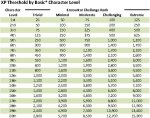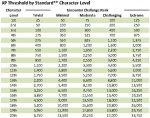dave2008
Legend
Since there have been a few of threads about the lack of interesting and/or threatening monsters in 5e I thought I would start discussing the revised monster and encounter design guidelines that I have been working on. First, to be clear I generally think 5e monsters are, especially at higher levels, a little weak. I do, however, find most of them interesting. Now, on to the task at hand. The first thing I wanted to get some feedback on was my revised XP Threshold by Character Level table (original on pg 82 of the DMG):
EDIT: version 2.0 of the table is attached now.
EDIT (1/13/16): version 3.0 of is up. Revised difficulty labels with alternate tables included.
Creating a Combat Encounter
When creating a combat encounter, let your imagination run wild and build something your players will enjoy. Once you have the details figured out, use this section to adjust the difficulty of the encounter.
Combat Encounter Difficulty
There are five categories of encounter difficulty that determine how challenging an encounter should be.
Trivial. A trivial encounter is non-challenging with little to no resource expenditure. It is a speed bump and mostly important for story or roleplaying engagement.
Minimally Challenging. In a minimal encounter the characters may expect to lose some hit points and spend a minimum of short or long rest resources, but they should complete the encounter with no casualties or major resource use. This encounter is rendered trivial with a minor increase in resource expenditure.
Moderately Challenging. In a moderate encounter the characters can expect to lose significant health resources (hit points and/or healing) and spend up to a quarter of their short or long rest resources. This encounter can be rendered minimal with an expenditure of additional resources.
Challenging. In a challenging encounter the characters can expect to lose about a third of their health, long rest, and short rest resources to escape. A character death is possible, but not likely. This encounter can be rendered moderate with an expenditure of additional resources.
Extremely Challenging. In an extreme encounter the characters can expect to lose half of their health, long rest, and short rest resources if they want to escape with their lives. A character or characters death is a real possibility. This encounter can be rendered challenging if the characters are able to expend the majority of their resources.

*Basic: Tables with this label assume a group is using the basic rules: no feats and no multi-classing. In addition, this table assumes the group consists of four characters: one cleric, one fighter, one rogue, and one wizard, or a similar.

**Standard: Tables with this label assume a group is using the full PHB: feats and multi-classing. In addition, this table assumes the group consists of four characters: one cleric, one fighter, one rogue, and one wizard, or a combination of similar diversity from multi-classing or class selection.
Evaluating Encounter Difficulty
Use the following method to gauge the difficulty of any combat encounter.
1. Determine XP Thresholds. First, determine which table to use: Basic or Standard, refer to the description under each table. Then determine the experience point (XP) thresholds for each character in the party. The XP Thresholds by Character Level tables have five XP thresholds for each character level, one for each category of encounter difficulty. Use a character’s level to determine his or her XP thresholds. Repeat this process for every character in the party.
2. Determine the Party’s XP Threshold. For each category of encounter difficulty, add up the characters’ XP thresholds. This determines the party’s XP threshold. You’ll end up with five totals, one for each category of encounter difficulty. For example, if your party includes three 3rd-level basic characters and one 2nd-level basic character, the party’s totaled XP thresholds would be as follows:
Trivial: 275 XP (75 + 75 + 75 + 50)
Minimal: 550 XP (150 + 150 + 150 + 100)
Moderate: 825 XP (225 + 225 + 225 + 150)
Challenging: 1,400 XP (400 + 400 + 400 + 200)
Extreme: 1,750 XP (500 + 500 + 500 + 250)
Record the totals, because you can use them for every encounter in your adventure.
3. Total the Monsters’ XP. Add up the XP for all of the monsters in the encounter. Every monster has an XP value in its stat block.
4. Modify Total XP for Multiple Monsters. If the encounter includes more than one monster, apply a multiplier to the monsters’ total XP. The more monsters there are, the more attack rolls you’re making against the characters in a given round, and the more dangerous the encounter becomes. To correctly gauge an encounter’s difficulty, multiply the total XP of all the monsters in the encounter by the value given in the Encounter Multipliers table. For example,…more to come!
EDIT: version 2.0 of the table is attached now.
EDIT (1/13/16): version 3.0 of is up. Revised difficulty labels with alternate tables included.
Creating a Combat Encounter
When creating a combat encounter, let your imagination run wild and build something your players will enjoy. Once you have the details figured out, use this section to adjust the difficulty of the encounter.
Combat Encounter Difficulty
There are five categories of encounter difficulty that determine how challenging an encounter should be.
Trivial. A trivial encounter is non-challenging with little to no resource expenditure. It is a speed bump and mostly important for story or roleplaying engagement.
Minimally Challenging. In a minimal encounter the characters may expect to lose some hit points and spend a minimum of short or long rest resources, but they should complete the encounter with no casualties or major resource use. This encounter is rendered trivial with a minor increase in resource expenditure.
Moderately Challenging. In a moderate encounter the characters can expect to lose significant health resources (hit points and/or healing) and spend up to a quarter of their short or long rest resources. This encounter can be rendered minimal with an expenditure of additional resources.
Challenging. In a challenging encounter the characters can expect to lose about a third of their health, long rest, and short rest resources to escape. A character death is possible, but not likely. This encounter can be rendered moderate with an expenditure of additional resources.
Extremely Challenging. In an extreme encounter the characters can expect to lose half of their health, long rest, and short rest resources if they want to escape with their lives. A character or characters death is a real possibility. This encounter can be rendered challenging if the characters are able to expend the majority of their resources.

*Basic: Tables with this label assume a group is using the basic rules: no feats and no multi-classing. In addition, this table assumes the group consists of four characters: one cleric, one fighter, one rogue, and one wizard, or a similar.

**Standard: Tables with this label assume a group is using the full PHB: feats and multi-classing. In addition, this table assumes the group consists of four characters: one cleric, one fighter, one rogue, and one wizard, or a combination of similar diversity from multi-classing or class selection.
Evaluating Encounter Difficulty
Use the following method to gauge the difficulty of any combat encounter.
1. Determine XP Thresholds. First, determine which table to use: Basic or Standard, refer to the description under each table. Then determine the experience point (XP) thresholds for each character in the party. The XP Thresholds by Character Level tables have five XP thresholds for each character level, one for each category of encounter difficulty. Use a character’s level to determine his or her XP thresholds. Repeat this process for every character in the party.
2. Determine the Party’s XP Threshold. For each category of encounter difficulty, add up the characters’ XP thresholds. This determines the party’s XP threshold. You’ll end up with five totals, one for each category of encounter difficulty. For example, if your party includes three 3rd-level basic characters and one 2nd-level basic character, the party’s totaled XP thresholds would be as follows:
Trivial: 275 XP (75 + 75 + 75 + 50)
Minimal: 550 XP (150 + 150 + 150 + 100)
Moderate: 825 XP (225 + 225 + 225 + 150)
Challenging: 1,400 XP (400 + 400 + 400 + 200)
Extreme: 1,750 XP (500 + 500 + 500 + 250)
Record the totals, because you can use them for every encounter in your adventure.
3. Total the Monsters’ XP. Add up the XP for all of the monsters in the encounter. Every monster has an XP value in its stat block.
4. Modify Total XP for Multiple Monsters. If the encounter includes more than one monster, apply a multiplier to the monsters’ total XP. The more monsters there are, the more attack rolls you’re making against the characters in a given round, and the more dangerous the encounter becomes. To correctly gauge an encounter’s difficulty, multiply the total XP of all the monsters in the encounter by the value given in the Encounter Multipliers table. For example,…more to come!
Last edited:










